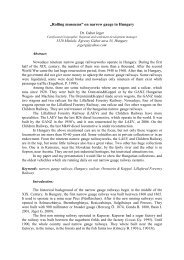'Representing Difficult Pasts within Complex Presents ... - T2M
'Representing Difficult Pasts within Complex Presents ... - T2M
'Representing Difficult Pasts within Complex Presents ... - T2M
Create successful ePaper yourself
Turn your PDF publications into a flip-book with our unique Google optimized e-Paper software.
(although Divall (2008) complains that in the London Transport Museum such approaches become<br />
didactic)?<br />
30<br />
One way could be to ensure the public contributed in some way to the museum – as in the District<br />
Six museum where community contributions in the form of comments, memorabilia, voices, photographs<br />
and creations form part of the museum. One idea might be to have, say, a photography competition, with<br />
people taking photos on cellphones while travelling and the best selected for museum display, thus<br />
encouraging more visitors. A way of recording visitor comments and ideas on issues such as environment<br />
and transport, could be a discussion forum on a computer where the best threads and comments are<br />
displayed 40 . The museum could also be a mode of voice for transport issues, to improve conditions,<br />
bearing in mind there is a need for a better and more accessible transport system in Cape Town (Pirie<br />
2009). Meetings could be held, complaints and suggestions for improvement registered.<br />
A museum of this kind could become a vibrant space for integrating the city; people from all<br />
regions making up the community. Even a huge interactive board where one can ‘access’ comments from<br />
people in different areas on what it is like and how it is to live there (with some possible monitoring in-<br />
between) is possible. Large electronic screens could be set up in different stations/places where people<br />
could talk with each other, or images displayed from other parts of the city the same day, showing people<br />
moving perhaps through different stations, or streets, a sense of interwoveness and interconnection<br />
evoked despite divided realities and contexts, to create an awareness of the whole 41 . Visual artists and<br />
performers could contribute and develop this concept. A wall of images of bus stops, stations, taxi ranks<br />
at different sites in Cape Town could also be very interesting and would depict the whole city on the go.<br />
To avoid ‘ethnographic fragmentation’ contemporary understandings of the museum would<br />
require perceptions of its archive as complex and multifaceted, challenging representations of colonial<br />
and apartheid histories in relation to the present. The museum should ideally be an intervention, providing<br />
multiple points of access and interpretation that leave the visitor questioning their own position and hstory<br />
in the world and to walk out the door looking differently at the city, wanting to know more. There might<br />
be ways developed of designing gaps, barriers that represent blockages, also manifest in transport history<br />
- perhaps in a metaphorical or experiential manner assigning routes that could not be taken, where<br />
understandings of ways in which people live and interconnect can be reworked. There is space also for<br />
40 The highly successful Hotel Yeoville 40 in Yeoville library, Johannesburg recently established<br />
collaborative multi-platform public art project works along these lines<br />
41 There is a display panel at the Transport Museum in London which does this between global city<br />
centres. (Visited 2010).




